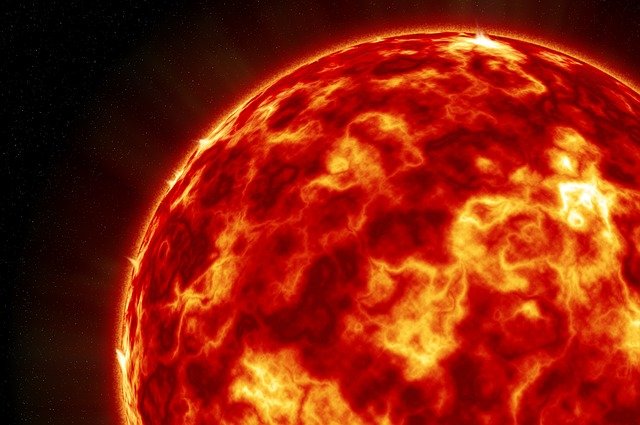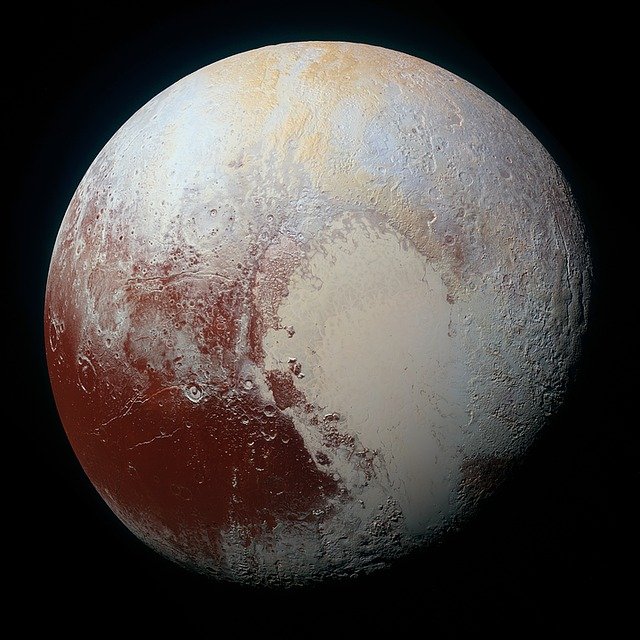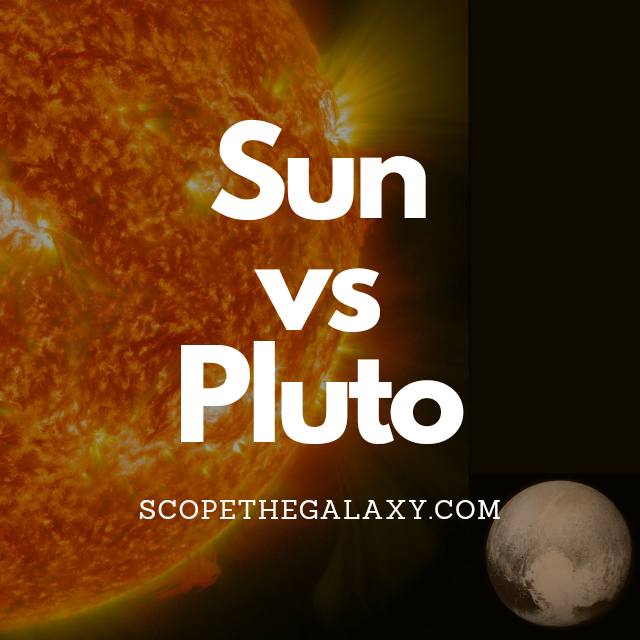*This post may contain affiliate links. This means we may make a commission if you purchase an item using one of our links*
The main differences between the Sun and Pluto is that the former is yellow dwarf star and the other a dwarf planet, Pluto is tidally locked to its moon whilst the Sun is not tidally locked to anything, Pluto orbits the Sun whilst the Sun orbits nothing and lastly the Sun is a scorching hot giant ball of fire whilst Pluto is a small, rocky and ice based dwarf planet.
Continue reading, for a more detailed breakdown of the many other differences between the two as well as the few commonalities they share.
What Is The Sun?
Table of Contents

The Sun is the bright, celestial entity at the center of our solar system and is also a star that falls under the G type main sequence star bracket (also called a yellow dwarfs), all of which are medium sized stars that tend to be around 0.84 – 1.15 solar masses.
Our Sun is 1 solar mass, making it a medium sized medium star. It’s also on the brighter side for a yellow dwarf, the color that it emits is white as opposed to the slightly yellow that less luminous yellow dwarfs would be.
Of course we still see the Sun as yellow or even red on Earth but, the reason for this significant color shift is because our atmosphere scatters and breaks up the photons that reach us, ultimately changing the true color of the light rays from white to the yellow, orange or red we see in our day to day.
As it is a star, the Sun will actively convert the hydrogen elements at its core into helium, through a process called nuclear fusion.
Nuclear fusion is the reason why it generates light and produces the energy we receive, helping us power machinery, technology, grow crops so on and so forth.
The process of nuclear fusion also affects how hot our star burns, allowing the sun to hit temperatures around 6000°C on a daily basis. This will be the case for another 4.5 – 5 billion years until it’s unable to convert hydrogen into helium.
Once hydrogen cannot be converted, an imbalance between the inward and outward forces keeping the Sun together will occur, causing an imbalance which would result in our Sun bloating up many many times its current size.
When this happens it will enter its red giant phase, where it’ll be around 256 times larger than it is now.
This phase will last for around a billion years until it sheds it mass through a process called planetary nebula, leaving behind only a dead white dwarf remnant.
What Is The Planet Pluto?

In the past Pluto was the 9th farthest official planet in our solar system however, in 2006 after many debates between astronomers, the International Astronomical Union officially downgraded it to a dwarf planet.
The reason for this downgrade at the time was primarily down to Pluto simply being too small when compared to every other planet and even the moons orbiting these planets. Pluto’s dwarf status is still debated to this day but, for now it remains under this dwarf bracket for a planet
Its diameter for example is only 2,370km, which is a third of Earth’s Moon. With that being said, despite the significant size discrepancy Pluto shows, it still does have more moon like objects orbiting it than Earth and I’m not saying just one more.
In total this terrestrial dwarf planet has 5.
Pluto’s atmosphere consists mostly of molecular nitrogen whilst molecules of methane and carbon monoxide have been observed also. As for its surface, it consist mostly of frozen nitrogen, methane, and carbon monoxide ices.
One of Pluto’s most unique characteristic is that Charon (its largest moon) is tidally locked to it and vice versa, which means that the two essentially orbit each other where, in essence only one side of Charon and one side of Pluto’s surface will face each other at any given time.
Pluto’s temperature is between -222 to -232 degrees Celsius based on how close it gets to the Sun when orbiting it, whilst its core temperature isn’t anything too special sitting around 500 – 1,000 degrees Celsius.
The main reason it’s as cold as it is and has a relatively cold core in comparison to the other planets would be mostly down to its size. A larger size would mean more mass could be compressed at the center which would produce more heat at the core.
Pluto’s orbit is also different from the other main plants in our solar system, following an elliptical orbital path as opposed to the circular path the others take. As a result of its distance from the Sun, Pluto will complete each one of these elliptical cycles around the Sun once every 247.78 years.
Even its rotational cycle is very slow, where one cycle is completed in 157 hours. Another interesting fact is the Pluto’s axial tilt is almost on its side at 57 degrees, similar to Uranus.
Similarities Between The Sun And Pluto
The Sun and Pluto don’t have too many similarities but there are still a few. Both are spherical in shape, both have other celestial objects orbiting them, both are part of the same solar system, and both have hotter cores.
Other than this, they don’t have too much else in common.
Differences Between The Sun And Pluto
As for the differences between the two, they include the following:
- Pluto has 5 moons orbiting it whilst the entirety of our solar system orbits the Sun.
- Pluto is tidally locked to its moon Charon whilst the Sun is not tidally locked to anything.
- The Sun orbits no other object but Pluto orbits the Sun in an elliptical orbital pattern.
- The Sun is much hotter than Pluto with surface temperatures around 6,000 degrees Celsius. Pluto is much cooler at -222 to -232 degrees Celsius.
- It’s take Pluto 157 hours to complete a day whilst the Sun completes a rotation in 27 days.
- It takes Pluto 247.78 years to orbit the Sun.
- Pluto is mostly ice and rock based whilst the sun is made of mostly hydrogen and helium.
- The Sun is able to produce light and energy through nuclear fusion whilst Pluto cannot do this.
- The Sun’s magnetic and gravitational fields are much stronger than Pluto’s.
- Pluto is only 2,370 km in diameter whilst the Sun’s diameter is 1.39 million km.
- The Sun will eventually die and become a white dwarf. Pluto does not have a set time frame for when it will die.
Summary
One is practically the smallest planet in our solar system whilst the other is the object that everything in the solar system orbits it.
As a result the differences are quite vast, from the size, temperature, how they function and how important they are for our solar system to function.
In the end of the day, besides the odd few similarities, the Sun and Pluto both fall under a different celestial object bracket and as a result don’t share much when it comes to their core functionality.


